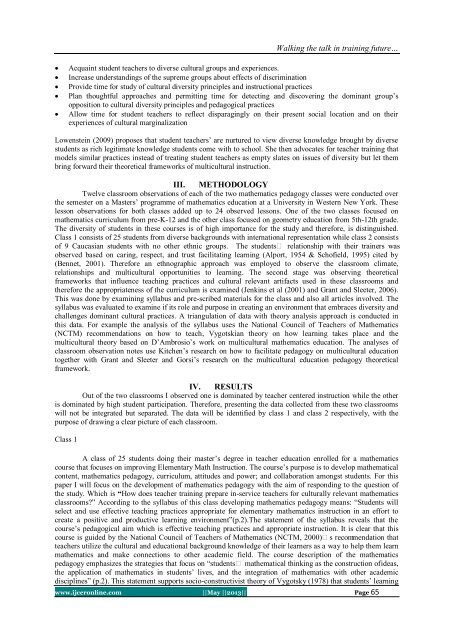Download - ijcer
Download - ijcer
Download - ijcer
You also want an ePaper? Increase the reach of your titles
YUMPU automatically turns print PDFs into web optimized ePapers that Google loves.
Walking the talk in training future…<br />
<br />
<br />
<br />
<br />
<br />
Acquaint student teachers to diverse cultural groups and experiences.<br />
Increase understandings of the supreme groups about effects of discrimination<br />
Provide time for study of cultural diversity principles and instructional practices<br />
Plan thoughtful approaches and permitting time for detecting and discovering the dominant group’s<br />
opposition to cultural diversity principles and pedagogical practices<br />
Allow time for student teachers to reflect disparagingly on their present social location and on their<br />
experiences of cultural marginalization<br />
Lowenstein (2009) proposes that student teachers’ are nurtured to view diverse knowledge brought by diverse<br />
students as rich legitimate knowledge students come with to school. She then advocates for teacher training that<br />
models similar practices instead of treating student teachers as empty slates on issues of diversity but let them<br />
bring forward their theoretical frameworks of multicultural instruction.<br />
III. METHODOLOGY<br />
Twelve classroom observations of each of the two mathematics pedagogy classes were conducted over<br />
the semester on a Masters’ programme of mathematics education at a University in Western New York. These<br />
lesson observations for both classes added up to 24 observed lessons. One of the two classes focused on<br />
mathematics curriculum from pre-K-12 and the other class focused on geometry education from 5th-12th grade.<br />
The diversity of students in these courses is of high importance for the study and therefore, is distinguished.<br />
Class 1 consists of 25 students from diverse backgrounds with international representation while class 2 consists<br />
of 9 Caucasian students with no other ethnic groups. The students‟ relationship with their trainers was<br />
observed based on caring, respect, and trust facilitating learning (Alport, 1954 & Schofield, 1995) cited by<br />
(Bennet, 2001). Therefore an ethnographic approach was employed to observe the classroom climate,<br />
relationships and multicultural opportunities to learning. The second stage was observing theoretical<br />
frameworks that influence teaching practices and cultural relevant artifacts used in these classrooms and<br />
therefore the appropriateness of the curriculum is examined (Jenkins et al (2001) and Grant and Sleeter, 2006).<br />
This was done by examining syllabus and pre-scribed materials for the class and also all articles involved. The<br />
syllabus was evaluated to examine if its role and purpose in creating an environment that embraces diversity and<br />
challenges dominant cultural practices. A triangulation of data with theory analysis approach is conducted in<br />
this data. For example the analysis of the syllabus uses the National Council of Teachers of Mathematics<br />
(NCTM) recommendations on how to teach, Vygotskian theory on how learning takes place and the<br />
multicultural theory based on D’Ambrosio’s work on multicultural mathematics education. The analyses of<br />
classroom observation notes use Kitchen’s research on how to facilitate pedagogy on multicultural education<br />
together with Grant and Sleeter and Gorsi’s research on the multicultural education pedagogy theoretical<br />
framework.<br />
IV. RESULTS<br />
Out of the two classrooms I observed one is dominated by teacher centered instruction while the other<br />
is dominated by high student participation. Therefore, presenting the data collected from these two classrooms<br />
will not be integrated but separated. The data will be identified by class 1 and class 2 respectively, with the<br />
purpose of drawing a clear picture of each classroom.<br />
Class 1<br />
A class of 25 students doing their master’s degree in teacher education enrolled for a mathematics<br />
course that focuses on improving Elementary Math Instruction. The course’s purpose is to develop mathematical<br />
content, mathematics pedagogy, curriculum, attitudes and power; and collaboration amongst students. For this<br />
paper I will focus on the development of mathematics pedagogy with the aim of responding to the question of<br />
the study. Which is “How does teacher training prepare in-service teachers for culturally relevant mathematics<br />
classrooms?” According to the syllabus of this class developing mathematics pedagogy means: “Students will<br />
select and use effective teaching practices appropriate for elementary mathematics instruction in an effort to<br />
create a positive and productive learning environment”(p.2).The statement of the syllabus reveals that the<br />
course’s pedagogical aim which is effective teaching practices and appropriate instruction. It is clear that this<br />
course is guided by the National Council of Teachers of Mathematics (NCTM, 2000)‟s recommendation that<br />
teachers utilize the cultural and educational background knowledge of their learners as a way to help them learn<br />
mathematics and make connections to other academic field. The course description of the mathematics<br />
pedagogy emphasizes the strategies that focus on “students‟ mathematical thinking as the construction of ideas,<br />
the application of mathematics in students’ lives, and the integration of mathematics with other academic<br />
disciplines” (p.2). This statement supports socio-constructivist theory of Vygotsky (1978) that students’ learning<br />
www.<strong>ijcer</strong>online.com ||May ||2013|| Page 65

















